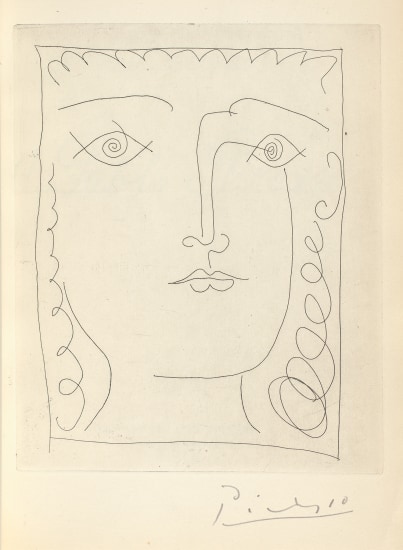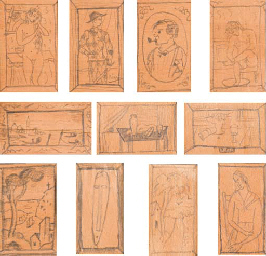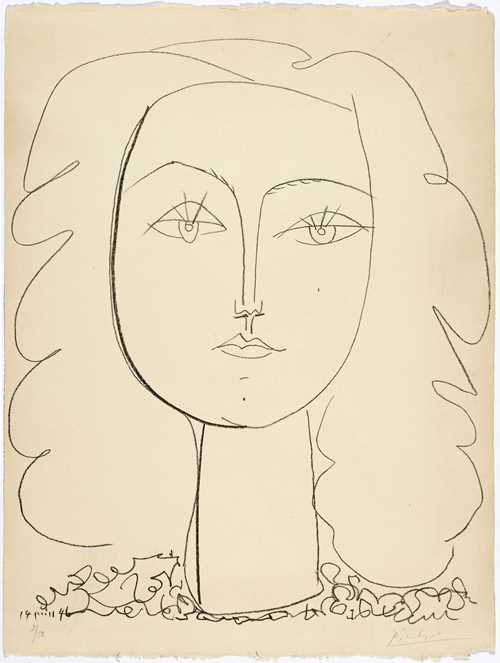Pablo Picasso Femmes Fleurs (Flower Women) 1947 White earthenware pitcher painted in colours with partial brushed glaze, 34.6 x 20 x 32 cm (13 5/8 x 7 7/8 x 12 5/8 in.) incised 'Edition Picasso R.152' and numbered 47/175 with the Madoura Plein Feu and Edition Picasso pottery stamps on the underside.
Provenance Private European Collection Literature Alain Ramié 50 (another example illustrated p. 41) Catalogue Essay “Picasso’s gift for description is nowhere more evident than in his ceramic work.” - Georges Ramié After the Second World War, over a period of some twenty years, Pablo Picasso modelled, shaped, carved and decorated over 3,500 fired clay objects at the Madoura Pottery. Aged 63, Picasso was already widely recognized as one of the leading artists of the twentieth century; celebrated as a revolutionary formal innovator, and lauded for his prolific mastery of a wide variety of artistic mediums. Having proven himself to be equally resourceful and virtuosic in painting, sculpture and printmaking, it is unsurprising that Picasso was eager to turn his hand to a previously unexplored material. As his son, Claude Picasso explained, in the 1998 Royal Academy, Picasso: Painter and Sculptor in Clay exhibition catalogue: “In creating or recreating these many objects in pottery, Picasso was extending his ongoing quest, in all his chosen media, for visual challenges that he could resolve in exciting and often unexpected ways.” Picasso first visited Vallauris in the summer of 1946, where he met Georges and Suzanne Ramié, the owners of the Madoura Pottery, and modelled a few clay animals at their studio. Upon his return the following summer, pleased with the results of his initial ceramic experiments, Picasso began to earnestly dedicate increasing periods of time to working from the Madoura studio, and within a year had created some 1,000 pieces. Georges Ramié spoke of this creative period with great fondness and admiration for Picasso’s narrative abilities in clay. In his introduction to the catalogue raisonné of Picasso’s ceramics, Ramié described how “…each piece has its own story, its own beginning: in a conversation, a visit, a trip or a corrida. Every event, internal or external, must be transcribed on the spot and simultaneously described by the way in which it is treated. Thus the fleeting impression is seized and immediately entrusted to the nearest messenger to hand.” All of Picasso’s ceramic pieces were earthenware, fired either in the old ‘Roman’ wood-fired kiln, under the supervision of Georges Ramié, or later, in electric kilns. Picasso was perhaps drawn to the unpredictable nature of the firing process, during which his clay pieces could crack and distort, but also through which the intensity of the glazed colours was revealed. The process of executing his designs therefore became just as spontaneous as the motifs he depicted and provided Picasso with yet another artistic challenge to master. Among the various ceramic techniques explored by Picasso, one method, termed empreintes originals, is notable for its similarities to traditional print-making. For these dishes and plates, Picasso created and designed unique plaster moulds, into which he would incise the lively images and forms that would decorate the finished works. Works from the editions created using these moulds bear the empreintes originals stamp on the reverse, as revealed by many of the pieces offered from the following Private European Collection. The works offered here illustrate a delightfully varied example of Picasso’s ceramic oeuvre. The profound influence of his Mediterranean environs and the inspiration drawn from its history and mythology resonates throughout this body of work. Picasso’s favoured ceramic subjects— fish, owls, vivacious centaurs, dancing nymphs, bearded men and coquettish women—conjure up an Arcadian idyll, a fictive utopia populated with a lively, anthropomorphized cast of characters. As George Ramié described, Picasso imbued these familiar figures with “characteristic vigour, or with no-less-characteristic gentleness, with impetuosity or charm, with all those elements of the unique personality revealed in his prolific creations.” The bold imagery, striking colours, spontaneity and wit of these important ceramics demonstrate P
Pablo Picasso Femmes Fleurs (Flower Women) 1947 White earthenware pitcher painted in colours with partial brushed glaze, 34.6 x 20 x 32 cm (13 5/8 x 7 7/8 x 12 5/8 in.) incised 'Edition Picasso R.152' and numbered 47/175 with the Madoura Plein Feu and Edition Picasso pottery stamps on the underside.
Provenance Private European Collection Literature Alain Ramié 50 (another example illustrated p. 41) Catalogue Essay “Picasso’s gift for description is nowhere more evident than in his ceramic work.” - Georges Ramié After the Second World War, over a period of some twenty years, Pablo Picasso modelled, shaped, carved and decorated over 3,500 fired clay objects at the Madoura Pottery. Aged 63, Picasso was already widely recognized as one of the leading artists of the twentieth century; celebrated as a revolutionary formal innovator, and lauded for his prolific mastery of a wide variety of artistic mediums. Having proven himself to be equally resourceful and virtuosic in painting, sculpture and printmaking, it is unsurprising that Picasso was eager to turn his hand to a previously unexplored material. As his son, Claude Picasso explained, in the 1998 Royal Academy, Picasso: Painter and Sculptor in Clay exhibition catalogue: “In creating or recreating these many objects in pottery, Picasso was extending his ongoing quest, in all his chosen media, for visual challenges that he could resolve in exciting and often unexpected ways.” Picasso first visited Vallauris in the summer of 1946, where he met Georges and Suzanne Ramié, the owners of the Madoura Pottery, and modelled a few clay animals at their studio. Upon his return the following summer, pleased with the results of his initial ceramic experiments, Picasso began to earnestly dedicate increasing periods of time to working from the Madoura studio, and within a year had created some 1,000 pieces. Georges Ramié spoke of this creative period with great fondness and admiration for Picasso’s narrative abilities in clay. In his introduction to the catalogue raisonné of Picasso’s ceramics, Ramié described how “…each piece has its own story, its own beginning: in a conversation, a visit, a trip or a corrida. Every event, internal or external, must be transcribed on the spot and simultaneously described by the way in which it is treated. Thus the fleeting impression is seized and immediately entrusted to the nearest messenger to hand.” All of Picasso’s ceramic pieces were earthenware, fired either in the old ‘Roman’ wood-fired kiln, under the supervision of Georges Ramié, or later, in electric kilns. Picasso was perhaps drawn to the unpredictable nature of the firing process, during which his clay pieces could crack and distort, but also through which the intensity of the glazed colours was revealed. The process of executing his designs therefore became just as spontaneous as the motifs he depicted and provided Picasso with yet another artistic challenge to master. Among the various ceramic techniques explored by Picasso, one method, termed empreintes originals, is notable for its similarities to traditional print-making. For these dishes and plates, Picasso created and designed unique plaster moulds, into which he would incise the lively images and forms that would decorate the finished works. Works from the editions created using these moulds bear the empreintes originals stamp on the reverse, as revealed by many of the pieces offered from the following Private European Collection. The works offered here illustrate a delightfully varied example of Picasso’s ceramic oeuvre. The profound influence of his Mediterranean environs and the inspiration drawn from its history and mythology resonates throughout this body of work. Picasso’s favoured ceramic subjects— fish, owls, vivacious centaurs, dancing nymphs, bearded men and coquettish women—conjure up an Arcadian idyll, a fictive utopia populated with a lively, anthropomorphized cast of characters. As George Ramié described, Picasso imbued these familiar figures with “characteristic vigour, or with no-less-characteristic gentleness, with impetuosity or charm, with all those elements of the unique personality revealed in his prolific creations.” The bold imagery, striking colours, spontaneity and wit of these important ceramics demonstrate P


.jpg?w=400)
.jpg?w=400)
.jpg)


.jpg?w=400)

.jpg)
.jpg)



.jpg?w=400)
Testen Sie LotSearch und seine Premium-Features 7 Tage - ohne Kosten!
Lassen Sie sich automatisch über neue Objekte in kommenden Auktionen benachrichtigen.
Suchauftrag anlegen